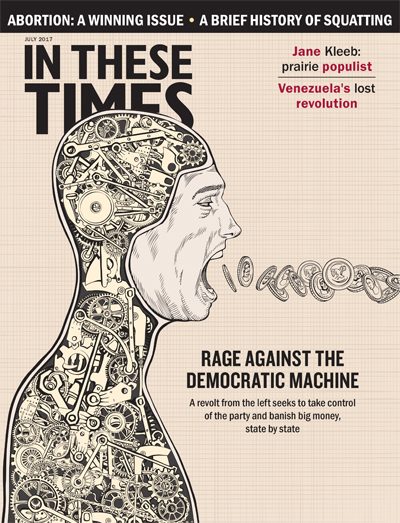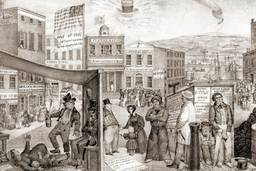Squatters’ 60-Year War Against Private Property
How propertied classes team up with the state to forcibly evict urban squatters.
Margaret Garb

Around 12:30 a.m. on August 7, 1988, a small army of police officers in riot gear covered their badges, raised their batons and charged on foot and on horseback into Tompkins Square Park on New York’s Lower East Side. The artists, punks, squatters, anarchists and evictees gathered there had expected a confrontation. With real estate developers circling the neighborhood, the local community board had imposed a 1:00 a.m. curfew on the park to try to clear out the homeless. But no one expected the callous violence, the armored police phalanx thundering down on bottle-throwing protesters. By daybreak, when the police retreated, 53 people were injured, including 14 police officers. Fourteen officers were later tried on brutality charges; none were convicted. The violence that summer night marked a turning point in the street battles over public space and housing in the postindustrial, rapidly gentrifying city.
Over the past 60 years, whenever squatters claimed homes in Western European and U.S. cities, even buildings long abandoned, the state used force to protect private property. After police violently removed squatters on the Lower East Side, some buildings were set on fire and others left decaying and empty. Property rights, not buildings — and certainly not housing for the homeless — were preserved.
The forced eviction of urban squatters is just one piece of Alexander Vasudevan’s The Autonomous City: A History of Urban Squatting. But in Vasudevan’s account, which leaps from New York City to Berlin, Amsterdam, Copenhagen, London and Vancouver, violence erupts again and again. Squatters — young and old, the desperately poor along with the utopian — are dragged from their homes by local police. Even as squatters sought the protection of court orders, nonprofit organizing and direct negotiation, violence proved the standard and savage response to the challenge to the capitalist property regime.
Vasudevan is a geographer and recently appointed fellow at Oxford University. The Autonomous City is dense and lively, culled from news accounts, court cases and interviews. This is not a balanced account of a contest over urban space (I did not see a single interview with a police officer). Rather it is an anecdote-filled essay on the politics and communal aspirations of various groups who took possession of urban buildings without holding the titles. For the work of a geographer, the specifics of each place are strangely missing— there’s little of what it felt like to live in a squat in 1970s London, say, or 1980s Copenhagen. Vasudevan is more concerned with the political than the material. That’s all right. Squatting demands to be understood as more than a refuge for the homeless. Instead, to condense Vasudevan’s analysis, it is political action designed to dispute the liberal (or neoliberal) state.
Some squatters, especially those in 1980s London and New York, needed affordable housing. But most, coming in the wake of 1960s-era student protests and the anti-war movement, aimed to produce a new kind of urban community. “The very choice to squat,” Vasudevan writes, “was also predicated on a refusal to accept the categories and structures imposed on them.”
Squatters formed protest cultures, or microcultures. There were squats organized by feminists, anti-racists and anti-consumerists. Many had ties to radical political movements, such as the Black Panthers or the Provos, a radical art collective in mid-1960s Amsterdam. (The group had launched smoke bombs at the 1966 wedding of Princess Beatrice.) They opened cafés and organized art exhibits. They issued manifestos and urban plans, remaking and reimagining the city as a place for democratic, egalitarian communities. The “right to the city,” Henri Lefebvre’s famous slogan, was to many of the squatters a lived practice, an assertion of rights to residential space and to alternative identities. Squatters in New York, Vasudevan writes, were “recover[ing] the disappearing use value of their neighborhood’s housing.”
Squatters, though unable to create cities free of capitalism, achieved some victories. In Amsterdam, where as many as 70,000 people lived in squats between 1964 and 1999, squatting became a broad political movement. A flashpoint came in 1975 when the city issued mass eviction notices as part of a plan to tear down Nieuwmarkt, a working-class neighborhood in the old Jewish quarter, and replace it with a subway, a four-lane highway and a business district. The neighborhood had stood near-empty since WWII, when the vast majority of the city’s Jews were deported and killed. The squatters who had occupied the buildings successfully pressured the city to scale back its plans, construct social housing and include residents in future planning. Squatting was no longer “a symbolic act of protest” but a movement able to alter the city’s housing market.
In 1970s Germany, by contrast, the experience of squatting proved violent and marginalizing. Squatters in Hamburg and Frankfurt were caught up in an intense struggle known as Häuserkampf (housing war) which ended with a “brutal clampdown.” In Hamburg in 1973, a police commando unit equipped with machine guns stormed a building and “viciously attacked” squatters. That traumatizing experience upended a nonviolent squatting movement.
Although squatters won occasional battles, they gradually lost the real estate war. On New York’s Lower East Side, squatters were followed by artists and punks, soon trailed by white hipsters and developers. By the night of the Tompkins Square Park riot, nearby tenements were being rehabbed and sold as high-end condos to the young elite. From New York to Vancouver to Amsterdam, rising property values have turned formerly decrepit squats into luxury condos.
The Tompkins Square Park riot was an expression of a disappearing Manhattan culture of working-class communities of artists, activists and hardworking families. It was, in addition, a powerful demonstration of an age-old capitalist weapon — state-sanctioned violence — and a reminder of the insidious bond between the urban propertied classes and the liberal state.








